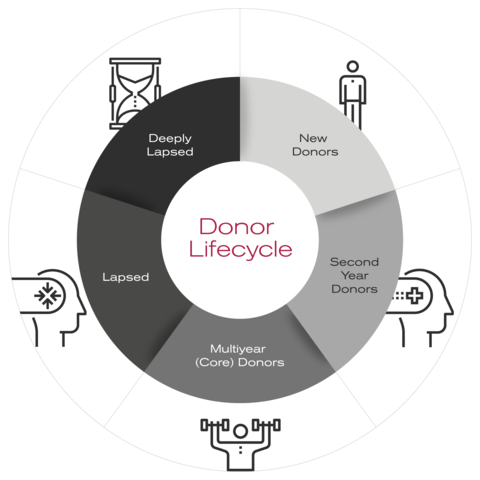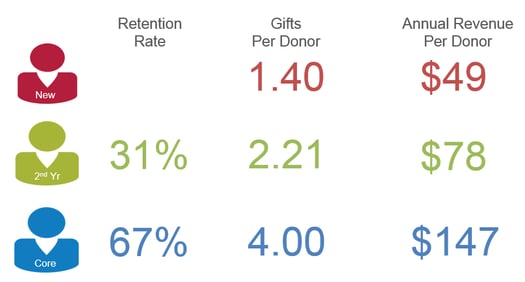Fewer than half of donors (42.6%) made repeat gifts to U.S. organizations in the past year, according to the 2022 Fundraising Effectiveness Report. As fundraisers, we know how crucial it is for new donors to quickly make a second gift. Paying attention to the donor lifecycle not only lets your organization know where it stands with donors, but it also lays the groundwork for a plan of attack to retain or regain donors.
But first, a refresher on the different lifecycles:
- New Donors: Donors who made their first gift to the organization
- Second-Year Donors: Donors who made their first gift to the organization last year and are available to renew
- Multiyear (Core) Donors: Donors who have given two or more consecutive years and are available to renew
- Lapsed Donors: Donors who have not given to your organization in more than one year
- Deeply Lapsed Donors: Donors who have not given to your organization in three or more years

What do we know about performance by donor lifecycle?
Understanding the donor lifecycle can make the difference in a successful fundraising program. At RKD, we believe growth of core (multiyear) donors is key to success, not necessarily growth in overall donor file size.
Why? We know that Core Donors:
- Are 2-3x more valuable than new donors
- Need 3-4 new donors to replace their revenue value, once lost
- Have a 100% higher retention rate
- Have a 100% higher response to direct mail than second-year donors
- Generate on average 70% - 85% of net revenue

Core donors are truly the heart of a healthy fundraising program. They are loyal and provide a steady and projectible revenue stream. These donors are primed to be upgraded into higher donor status, such as mid-level, major and planned giving programs. Keeping a healthy core donor file is the most important thing you do for overall donor file health.
Why is evaluating results by donor lifecycle important?
1. It helps organizations decide where to invest.
For example, would you spend a little more budget to prevent a core donor from lapsing?
For one client, we mailed a special matching challenge package to core donors who had not yet renewed. We were able to renew 1,800 core donors, with a $45 average gift. If these donors had not renewed, it would have effectively cost the organization almost $250,000 in acquisition expense to acquire enough new donors to offset the revenue.
While we can optimize direct response tactics to improve core donor retention, attrition is a natural part of any file. To make up for these lapsing donors, it’s crucial to invest enough in new donor acquisition.
2. It helps create a donor renewal strategy.
Typically, second-year donors have the lowest renewal rates. However, if your second-year renewal rate is low, consider whether you are acquiring the right donors at acquisition.
We know that donors with a low initial gift renew at low rates the subsequent year. For the health of the file, it might be worth acquiring fewer new donors at a higher average gift.
3. It helps determine a communication stream for new donors.
We know that new donors who give a second gift to an organization are four times more likely to renew the following year.
How can your welcome communication be improved to get a second gift more quickly? Here are a few thoughts on how to plug the leaks.
Applying lifecycles to your strategy
The donor lifecycle is just one lens to look through, but a helpful one in reporting, planning and consistent evaluation. As you begin to map out the next fiscal budget, consider using this method to see where to allocate more time and resources.
A lifecycle audit might be just what you need to develop or adjust strategies and budgets to retain and upgrade the donors you already have, and to successfully identify the best donor prospects.






Leave a comment: